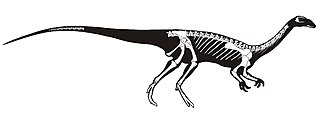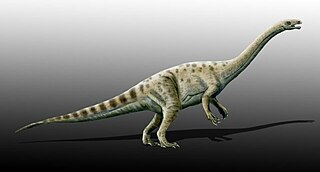
Sauropodomorpha is an extinct clade of long-necked, herbivorous, saurischian dinosaurs that includes the sauropods and their ancestral relatives. Sauropods generally grew to very large sizes, had long necks and tails, were quadrupedal, and became the largest animals to ever walk the Earth. The prosauropods, which preceded the sauropods, were smaller and were often able to walk on two legs. The sauropodomorphs were the dominant terrestrial herbivores throughout much of the Mesozoic Era, from their origins in the Late Triassic until their decline and extinction at the end of the Cretaceous.

Staurikosaurus is a genus of herrerasaurid dinosaur from the Late Triassic of Brazil, found in the Santa Maria Formation.

Saturnalia is an extinct genus of basal sauropodomorph dinosaur known from the Late Triassic Santa Maria Formation of Rio Grande do Sul, southern Brazil. It is one of the earliest known dinosaurs.

Herrerasauridae is a family of carnivorous dinosaurs, possibly basal to either theropods or even all of saurischians, or even their own branching from Dracohors, separate from Dinosauria altogether. They are among the oldest known dinosaurs, first appearing in the fossil record around 233.23 million years ago, before becoming extinct by the end of the Carnian stage. Herrerasaurids were relatively small-sized dinosaurs, normally no more than 4 metres (13 ft) long, although the holotype specimen of "Frenguellisaurus ischigualastensis" is thought to have reached around 6 meters long. The best known representatives of this group are from South America, where they were first discovered in the 1930s in relation to Staurikosaurus and 1960s in relation to Herrerasaurus. A nearly complete skeleton of Herrerasaurus ischigualastensis was discovered in the Ischigualasto Formation in San Juan, Argentina, in 1988. Less complete possible herrerasaurids have been found in North America and Africa, and they may have inhabited other continents as well.
Sankar Chatterjee is a paleontologist, the Paul W. Horn Professor of Geosciences at Texas Tech University and Curator of Paleontology at the Museum of Texas Tech University. He earned his Ph.D. from the University of Calcutta in 1970 and was a Post-doctoral Fellow at the Smithsonian Institution from 1977-1978.

Lufengosaurus is a genus of massospondylid dinosaur which lived during the Early Jurassic period in what is now southwestern China.

Alwalkeria is a genus partly based on basal saurischian dinosaur remains from the Late Triassic, living in India.

Massospondylidae is a family of early massopod dinosaurs that existed in Asia, Africa, North America, South America and Antarctica during the Late Triassic to the Early Jurassic periods. Several dinosaurs have been classified as massospondylids over the years. The largest cladistic analysis of early sauropodomorphs, which was presented by Apaldetti and colleagues in November 2011, found Adeopapposaurus, Coloradisaurus, Glacialisaurus, Massospondylus, Leyesaurus and Lufengosaurus to be massospondylids. This result supports many previous analyses that tested fewer taxa. However, this analysis found the two recently described North American massopods, Sarahsaurus and Seitaad, and the South African Ignavusaurus to nest outside Massospondylidae, as opposed to some provisional proposals. Earlier in 2011, Pradhania, a sauropodomorph from India, was tested for the first time in a large cladistic analysis and was found to be a relatively basal massospondylid. Mussaurus and Xixiposaurus may also be included within Massospondylidae.
Pradhania is a genus of massospondylid sauropodomorph dinosaur from the Sinemurian-age Upper Dharmaram Formation of India. It was first named by T. S. Kutty, Sankar Chatterjee, Peter M. Galton and Paul Upchurch in 2007 and the type species is Pradhania gracilis. It was a sauropodomorph of modest size, only about four meters (13 ft) long, and is known from fragmentary remains. It was originally regarded as a basal sauropodomorph but new cladistic analysis performed by Novas et al., 2011 suggests that Pradhania is a massospondylid. Pradhania presents two synapomorphies of Massospondylidae recovered in their phylogenetic analysis.

Plateosauria is a clade of sauropodomorph dinosaurs which lived during the Late Triassic to the Late Cretaceous. The name Plateosauria was first coined by Gustav Tornier in 1913. The name afterwards fell out of use until the 1980s.
The Nam Phong Formation, which correlates to the Indosinian III Unconformity, is a geological formation in Thailand. It underlies the Khorat Group. It consists of resistant, red-brown micaceous sandstones, conglomerates, siltstones and mudstones of mainly fluvial origin. The sandstones are medium to very fine-grained and are usually calcareous. The conglomerates contain pebbles of quartz, brown and grey chert, and reddish brown siltstone. Cross bedding and plane-bed stratification are common in the sandstones and conglomerates. The sandstones and conglomerates make up approximately 30% of the formation. This sedimentary rock formation is found in Khon Kaen Province, Thailand. It is of Norian to Rhaetian age to age, and is notable for its fossils of early dinosaurs.
Nambalia is a genus of basal sauropodomorph dinosaur. It lived during the Late Triassic period in what is now Telangana, central India. It is known from the holotype ISI R273, parts 1–3, partially articulated postcranial material and from the paratypes ISI R273, parts 4-29, including partial postcrania of at least two individuals of different sizes found closely associated and one of them is nearly the same size as the holotype.
The Pranhita–Godavari Basin is a northwest–southeast striking geological structural basin in eastern India. The basin contains up to 7 kilometres of sedimentary strata of late Carboniferous/Early Permian to Cretaceous age. The basin is 400 km in length with a width of about 100 km and is terminated by the coast of the Indian Ocean on the southeast end.
The Upper Maleri Formation is a sedimentary rock formation found in Telangana, India. It is one of the formations of the Pranhita–Godavari Basin. It is of late Norian and possibly earliest Rhaetian ages, and is notable for its fossils of early dinosaurs.
The Lower Maleri Formation is a sedimentary rock formation found in Andhra Pradesh and Telangana, India. It is the lowermost member of the Pranhita–Godavari Basin. It is of late Carnian to early Norian age, and is notable for its fossils of early dinosaurs, including the basal saurischian Alwalkeria.
The Lower Dharmaram Formation is a sedimentary rock formation found in Andhra Pradesh, India. It is one of the formations of the Pranhita–Godavari Basin. It is of latest Norian and Rhaetian ages, and is notable for its fossils of early dinosaurs.
Martín Dário Ezcurra is an Argentine palaeontologist naming many extinct genera such as Aerotitan, Lophostropheus and Powellvenator.

Unaysauridae is a clade of basal sauropodomorphs from the Late Triassic of India and Brazil.

Nhandumirim is a genus of basal sauropodomorph dinosaur from the Carnian age of Late Triassic Brazil. It is currently considered a saturnaliid sauropodomorph. The type and only species, Nhandumirim waldsangae, is known from a single immature specimen including vertebrae, a chevron, pelvic material, and a hindlimb found in the Santa Maria Formation in Rio Grande do Sul.




















